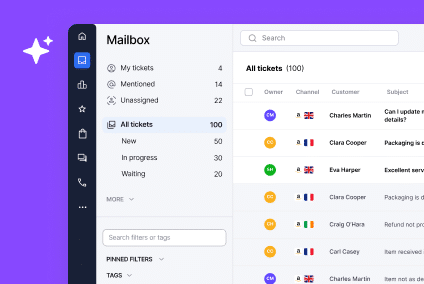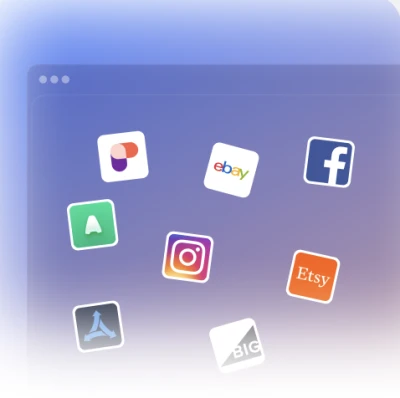Consumers are dramatically changing the face of customer service, and with the latest technologies helping to make businesses more available, consumers are demanding 24/7 accessibility, as opposed to traditional 9-5 call-in hours. With this in mind, customer service itself is having to evolve, and how customers are approached with any form of marketing or interaction needs to be tailored and personalized.
In 2025, 93% of customer service teams agree that customer expectations are higher than ever before, and 65% of customers expect a faster response time than they did five years ago. With 80% of people regularly encountering negative customer service experiences, businesses need to step up their game to meet these evolving demands.
In this post, we’re taking a look at three things your consumers are expecting from your customer service.
1. 24/7 AI-Powered Responses
Consumers are now looking to be in control, meaning you have to ensure that your customer service is available 24/7, 365 days per year. Consumers are looking to decide when the interaction takes place between them and the business they are looking to purchase from, and as a result, they want to ensure that all conversations are seamless.
By 2025, AI is expected to handle 95% of all customer interactions, and 85% of customer interactions are expected to be handled without human involvement, thanks to AI and automation. This represents a fundamental shift in the face of customer service, where AI-powered tools ensure continuous availability while maintaining quality support.
With 80% of customer service and support organizations using generative AI to improve agent productivity and overall customer experience, businesses are leveraging intelligent automation to provide instant responses. Technologies such as social media can provide your business with new ways to interact with your customers, all day, every day, and you are able to pick up responses on new platforms such as social media.
The more responsive your business appears, the better off your reputation, no matter whether you’re responding to a customer query or a complaint. 81% of customers attempt to resolve issues themselves before reaching out to a live representative, making self-service capabilities essential for modern face-to-face customer service experiences.
2. Go Mobile and Omnichannel
Mobile commerce is projected to account for 72.9% of all eCommerce sales by 2025, meaning your business will need to offer a seamless mobile service at all times. By 2025, 80% of customer service organizations will move away from native mobile apps and use messaging instead for a better customer experience.
Technology can provide you with new ways to help make your customer service easier, and by going mobile, you are able to integrate SMS, instant messaging, and social media into your customer service methods. With social media becoming a popular way to interact with brands, being able to offer this to your consumers can help you broaden your audience opportunities.
An omnichannel approach to customer service is becoming increasingly important in 2025. 47% of eCommerce decision-makers in Europe and North America consider omnichannel strategies to be very important for their business. This means offering a seamless experience across all your customers’ communication channels, not just live chat.
Contrary to past trends, 71% of Gen Z would now reach out to customer support via a live phone call, while 62% of customers think experiences should flow naturally between both physical and digital spaces. This demonstrates that the face of the customer service landscape must accommodate diverse channel preferences while maintaining consistency.
3. Personalized and Instant Solutions
Gone are the days when consumers are happy to spend hours on the phone, waiting on hold to speak to the right department. Now, consumers want quick and easy answers to the questions that they have, and more often than not, consumers are happy to find the answers out themselves.
71% of consumers expect companies to deliver personalized interactions, highlighting the growing demand for tailored customer experiences. Additionally, 76% of customers get frustrated when they don’t receive personalized experiences, indicating the negative impact of generic service.
Studies show that 45% of U.S. adults will abandon their online purchases if they are unable to find the answer to a query. In addition to this, 66% of consumers believe that one of the most important parts of customer service is saving time. Consumers are more self-reliant than ever before, and if your business provides an extensive FAQs section with AI-powered search capabilities, then you are much more likely to retain the business you desire.
Modern customer service software leverages AI to provide instant, personalized responses. 69% of customers prefer to use self-service options like a knowledge base or chatbot over contacting support. 88% of customers expect a self-service support portal from a brand or organization, and 79% expect organizations to provide self-service support tools to help customers find answers without contacting support.
The Role of AI in Modern Customer Service
Artificial intelligence is revolutionizing how businesses approach customer support. 80% of companies plan to increase their level of investment in customer experience, with AI being a primary focus. Early adopters are seeing significant results:
- 80% savings in the time it takes to create case summaries
- 80% less time agents spend typing when resolving support requests
- 10% to 20% productivity increases across customer service teams
- 30% reduction in customer service operational costs
Companies implementing AI chatbots have reported substantial cost reductions, with some businesses saving millions by automating customer service processes. For every $1 invested in AI, businesses have seen an average return of $3.50, with some companies reporting returns of $8.
Customer Service Tools and Technologies for 2025
The customer service tools landscape has evolved significantly. Modern businesses are adopting:
AI-Powered Chatbots and Virtual Assistants
- Natural language processing capabilities
- 24/7 availability with instant responses
- Integration with multiple communication channels
Predictive Analytics
- Anticipating customer needs before issues arise
- Forecasting service demands and staffing requirements
- Identifying at-risk customers for proactive outreach
Omnichannel Support Platforms
- Unified customer data across all touchpoints
- Seamless transition between channels
- Consistent experience regardless of communication method
For eCommerce businesses looking to implement these technologies, platforms like eDesk provide comprehensive customer support solutions that integrate with multiple marketplaces and channels. Learn more about eCommerce customer support and how AI in eCommerce can transform your customer service operations.
The Human Element in AI-Driven Service
While AI handles the majority of routine inquiries, the human element remains crucial for complex issues requiring empathy and critical thinking. 72% of business leaders believe merging teams and responsibilities around the customer experience will increase operational efficiencies.
The most successful businesses in 2025 are those that create a hybrid model where AI handles routine tasks while human agents focus on:
- Complex problem-solving
- Emotional support and empathy
- Relationship building
- Escalated issues requiring judgment calls
Meeting Rising Customer Expectations
Consumer expectations continue to rise, with 86% of agents and 74% of mobile workers saying customer expectations are higher than they used to be. To meet these expectations, businesses must:
- Implement proactive service strategies that anticipate customer needs
- Invest in AI and automation to provide instant, accurate responses
- Maintain the human touch for complex or emotionally charged situations
- Ensure consistency across all customer touchpoints
- Continuously gather and act on feedback to improve service quality
For marketplace sellers, understanding customer service expectations is particularly important. Check out guides on Amazon seller customer support, how to increase sales on eBay, and Shopify customer service apps to optimize your approach.
Final Thoughts
The rise in technology means consumers are demanding fast, real-time responses from brands, no matter their query. With 96% of consumers trusting a brand more when companies make it easy to do business with them, and face-to-face customer service evolving to include digital interactions, the stakes have never been higher.
With so many opportunities to interact with your business through modern face customer service software and tools, informing your consumers and saving them time can allow your business new opportunities to provide your customers with the customer service that they desire.
The businesses that thrive in 2025 will be those that successfully balance AI automation with human expertise, creating seamless, personalized experiences that exceed customer expectations at every touchpoint. By embracing these changes and investing in the right technologies, you can transform customer service from a cost center into a competitive advantage that drives growth and loyalty.
Book a free demo to learn more about how eDesk can optimize your customer service operations.




